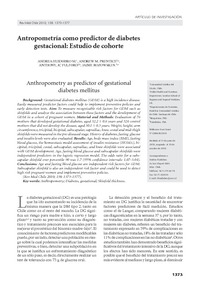Antropometría como predictor de diabetes gestacional: Estudio de cohorte
Autor
Huidobro-Muñoz, Andrea
Prentice, Andrew M.
Fulford, Anthony
Rozowski N., Jaime
Fecha
2010Resumen
Background: Gestational diabetes mellitus (GDM) is a high incidence disease. Easily measured predictor factors could help to implement preventive policies and early detection tests. Aim: To measure recognizable risk factors for GDM such as skinfolds and analyze the association between these factors and the development of GDM in a cohort of pregnant women. Material and Methods: Evaluation of 76 mothers that developed gestational diabetes, aged 32.2 ± 0.6 years and 324 control mothers that did not develop the disease, aged 30.1 ± 0.3 years. Weight, height, arm circumference, tricipital, bicipital, subscapular, suprailiac, knee, costal and mid-thigh skinfolds were measured in the pre-diseased stage. History of diabetes, fasting glucose
and insulin levels were also evaluated. Results: Age, body mass index (BMI), fasting blood glucose, the homeostasis model assessment of insulin resistance (HOMA), bicipital, tricipital, costal, subscapular, suprailiac, and knee skinfolds were associated with GDM development. Age, fasting blood glucose and subscapular skinfolds were independent predictors in the logistic regression model. The odds ratio for a subscapular skinfold over percentile 90 was 1.7 (95% confidence intervals: 1.07-3.04). Conclusions: Age and fasting blood glucose are independent risk factors for GDM. Subscapular skinfold is also an independent risk factor and could be used to detect high risk pregnant women and implement preventive policies.
Fuente
Revista Médica de Chile, 138(11), 1373-1377Identificador DOI
dx.doi.org/10.4067/S0034-98872010001200005Colecciones
La publicación tiene asociados los siguientes ficheros de licencia:


